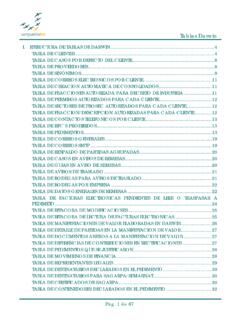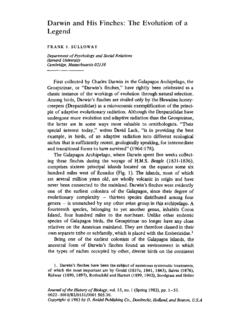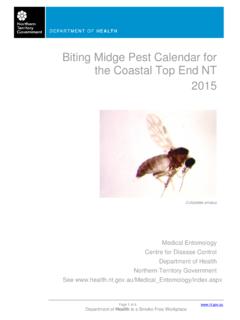Transcription of Darwin’s allegorical ‘warm little pond’ was most Life …
1 40 February 2009 2009 The Biochemical SocietyEvolutionFeaturesKey words: abiogenesis, astrobiology, Oparin Haldane chemistry, panspermia, RNA world, Urey Miller experimentAstrobiology and panspermiaDarwin s allegorical warm little pond was most probably located outside the Earth and Darwinianevolution, including genetic exchanges and transfers, occurred over a vast galactic did life arise? Not just on the Earth, but anywhere in the Universe? Does life emerge readily on every Earth-like planet by spontaneous processes involving well-attested laws of physics and chemistry, or did it involve an extraor-dinary, even miraculous intervention? Science must neces-sarily exclude a miraculous option of course, but the other questions continue to be Darwin, the bicentenary of whose birth we cel-ebrate this year, and who laid the foundations of evolution-ary biology, never alluded to the origin of life in his 1859 book On the Origin of Species1.
2 He had, however, thought about the problem and formulated his own position in a letter to Joseph Hooker in 1871 thus: ..It is often said that all the conditions for the first production of a living organism are now present, which could ever have been present. But if (and oh! what a big if!) we could conceive in some warm little pond, with all sorts of ammonia and phosphoric salts, light, heat, electricity, &c., present, that a proteine compound was chemically formed ready to undergo still more com-plex changes, at the present day such matter would be instantly absorbed, which would not have been the case before living creatures were found. Darwin s prescient remarks provided the basic scientific framework for exploring the problem of abio-genesis throughout the 20th Century and beyond.
3 In the late 1920s, Oparin2 and Haldane3 fleshed out Darwin s thoughts into the familiar Primordial Soup Theory , proposing that the atmosphere of the primi-Chandra Wickramasinghe (Cardiff University)Life from spacetive Earth comprised of a reducing mixture of hydrogen, methane, ammonia and other compounds from which the monomers of life could be readily generated. Primitive lightening and solar UV radiation provided the energy to dissociate these molecules, and the radicals so formed recombined through a cascade of chemical reactions to yield biochemical monomers such as amino acids, nucleotide bases and sugars. In the 1950s, the classic exper-iments of Harold Urey and Stanley Miller4 demonstrated the feasibility of the Oparin Haldane chemistry, and thus led to the belief that life could be generated de novo as soon as the biochemical monomers were in place.
4 The formation of the first fully-functioning, self-replicating life system with the potential for Darwinian evolution still remains an elusive concept, recent years the fledgling science of astrobiology has taken up the challenge of extending the Oparin Haldane ideas of abiogenesis to a wider cosmic canvas. This has been prompted in large measure by the discovery of biochemi-cally relevant molecules such as polyaromatic hydrocar-bons in interstellar space, an identification first reported in the journal Nature by Fred Hoyle and myself in 19775. Such molecules have now been inferred to exist in vast quantity outside the confines of the Milky Way, extending even as far as a galaxy 8 billion light years away6(Figure 1).
5 Figure 2 shows a part of a giant molecular cloud in the Orion Nebula of our own galaxy which is choc-a-bloc with PAHs (polycyclic aromatic hydrocarbons) and a wide range of other molecules, both organic and inorganic. Here is an active site of star-births, the youngest stars be-ing younger than a few million years, and including many 41 FeaturesFebruary 2009 2009 The Biochemical SocietyEvolutionnascent planetary systems (protoplanetary nebulae). This veritable stellar and planetary nursery is surely a region where a Urey Miller experiment may be taking place on a grand cosmic scale. I shall argue as an alternative that it may also represent a graveyard of life PAHs and other molecules present here arising from the destruction and degradation of life (see Figure1a).
6 It is generally conceded that the path from chemicals to self-replicating biology must progress through a sequence of organisational steps. The most popular contender for one such early stage is the RNA world. In this model, nucleotides polymerize into random RNA molecules that lead to autonomously self-replicating macromolecules (ri-bozymes) without the need for an intermediary enzyme7,8. Likewise, other contenders of prebiotic development in-clude the iron sulphur world 9, the PNA (peptide nucleic acid) world 10 and the clay world 11, the latter involving an inorganic clay system serving as the informational template. In view of the high abundance of silicon in the galaxy, the clay world model might well have a special role to play in a cosmic context, as we shall see.
7 The transition from any of these intermediate systems to the final DNA/protein-based cellular life form is still in the realm of speculation. The difficulty of finding unequivocal evidence of the relics of prebiology in the geological record has been a handicap for Earth-based theories of the origin of life. The suite of organics present in interstellar clouds, as in Figure 2, consistently directs our search for origins away from Earth to more and more distant parts of the Universe. At the very least the organic molecules needed for life s origins are much more likely to have been generated in a cosmic context rather than being formed in situ on Earth. Moreover, it is now becoming clear that life arose on Earth almost at the very first moment that it could have survived.
8 During the period from about by ago (the Hadean Epoch), the Earth suffered an episode of heavy bombard-ment by comets and asteroids. Rocks dating back to the tail end of this epoch reveal evidence of an excess of the lighter isotope 12C compared with 13C pointing to the action of micro-organisms that preferentially take up the lighter isotope from the environment12, success of the Urey Miller experiment in 1953 led to the feeling that it was only a matter of time before the next steps from biochemical monomers to life could be demonstrated in the laboratory. Despite over half a century of effort, this goal has proved stubbornly elusive. If one accepts the calculations showing grotesquely small a priori probabilities for the transition of non-life to life14 16, Antennae (ISOCAM)Qabs ( )AnthraciteNe ( m)67892 1.
9 (a) At a distance of 63 million light years the Antennae galaxies show clear evidence of anthracite-like dust, consistent with a biological degradation product. (b) In the gravitational lens galaxy SBS0909+532, at a red-shift of z= , correspond-ing to a distance of nearly 8 billion light years, a UV absorption signature centred on 2175 consistent with biological aromatic polymers. A similar signature in dust of own galaxy was first at-tributed to biomaterial by Hoyle and Wickramasinghe in 1977540156 Normalized extinction excessWavenumber 1/2 ( m 1)Curve Biological aromatic ensemblePoints Extinction of SBS0909 + 53242 FeaturesFebruary 2009 2009 The Biochemical SocietyEvolutionit would appear that only two options remain open: the ori-gin of life on Earth was an extremely improbable event that occurred and will effectively not be reproduced elsewhere; or, a very much bigger system than was available on Earth, and a longer timescale was involved in an initial origination event, after which life was somehow transferred to Earth.
10 In collaboration with Fred Hoyle, I have argued in favour of the latter option15 17, while others may prefer to discard the probability argument as insecure, and assert that life must of necessity arise readily by an undiscovered process whenever and wherever the right conditions are molecular clouds in Orion are of course much bigger in scale than anything on Earth, but in the gase-ous interstellar medium all that one could really hope to achieve is the production of organic molecules through gas-phase chemistry. These organic molecules must then enter a watery medium in suitably high concentrations to begin the presumptive prebiotic chemistry that may have eventually led to life.




